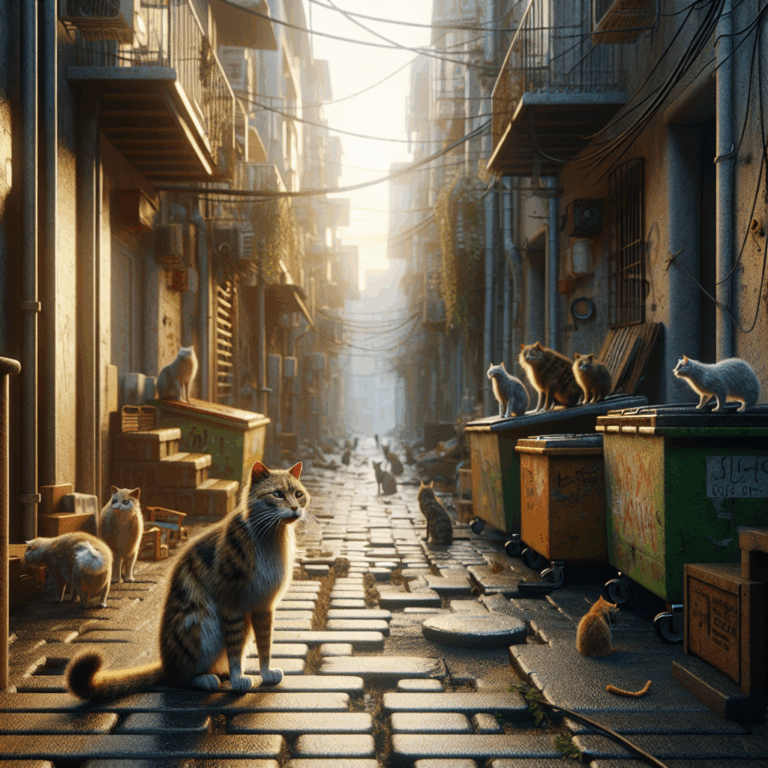The Feline Phenomenon: Exploring the Lives of Cats in Urban Environments
- 22 Comments
As cities across the globe continue to expand, the urban landscape presents a unique set of challenges and opportunities for our feline friends. The adaptation of cats to urban environments is a fascinating phenomenon that offers insights into their remarkable resilience and resourcefulness. While domestic cats have been part of human settlements for thousands of years, the modern cityscape poses new dynamics that these agile creatures must navigate.
Urban environments, with their bustling streets and towering skyscrapers, are a stark contrast to the rural settings where cats have historically thrived. Yet, cats have shown an impressive ability to acclimate to city life. This adaptability is partly due to their natural curiosity and problem-solving skills, which enable them to explore and utilize urban spaces in innovative ways. From alleyways to rooftops, cats have claimed these territories, often forming unique colonies within city limits.
One of the key challenges cats face in urban areas is the availability of resources. Unlike their rural counterparts, city cats must rely on a patchwork of sources for food and shelter. This has led to a complex relationship with humans, who often provide sustenance either directly through feeding or indirectly by leaving behind edible scraps. Some cities have even established feeding programs for stray cats, acknowledging their role in controlling rodent populations and maintaining ecological balance.
However, urban life isn’t without its perils. Traffic poses a significant danger, and cats must learn to navigate busy roads safely. Additionally, the density of urban populations can lead to competition among cats for territory and resources, sometimes resulting in aggressive encounters. Despite these challenges, many urban cats display a remarkable degree of socialization, often forming loose-knit communities that share resources and provide mutual protection.
The presence of cats in cities also raises questions about wildlife conservation. Urban cats can have a significant impact on local ecosystems, particularly bird populations. This has sparked debates among conservationists and cat enthusiasts alike, as cities seek to balance the needs of wildlife with the presence of these charming yet effective predators.
Interestingly, the urban cat phenomenon has also contributed to a growing cultural presence. Street cats have become iconic in many cities, inspiring art, literature, and even tourism. In Istanbul, for instance, cats are celebrated as part of the city’s identity, with residents and tourists alike captivated by their omnipresence and charm.
As urbanization continues to shape the future, understanding the dynamics of cats in these environments becomes increasingly important. Researchers and city planners are beginning to take note, exploring ways to create more cat-friendly cities that cater to the needs of both human and feline inhabitants. This includes designing green spaces and urban infrastructure that accommodate the natural behaviors of cats, ensuring they can continue to thrive alongside us.
In conclusion, the story of cats in urban environments is a testament to their indomitable spirit and adaptability. As we look to the future, fostering a harmonious coexistence between humans and cats in cities will require creativity, compassion, and a deeper understanding of these remarkable animals that have become an integral part of urban life.

As cities across the globe continue to expand, the urban landscape presents a unique set of challenges and opportunities for our feline friends. The adaptation of cats to urban environments is a fascinating phenomenon that offers insights into their remarkable resilience and resourcefulness. While domestic cats have been part of human settlements for thousands of years, the modern cityscape poses new dynamics that these agile creatures must navigate.
Urban environments, with their bustling streets and towering skyscrapers, are a stark contrast to the rural settings where cats have historically thrived. Yet, cats have shown an impressive ability to acclimate to city life. This adaptability is partly due to their natural curiosity and problem-solving skills, which enable them to explore and utilize urban spaces in innovative ways. From alleyways to rooftops, cats have claimed these territories, often forming unique colonies within city limits.
One of the key challenges cats face in urban areas is the availability of resources. Unlike their rural counterparts, city cats must rely on a patchwork of sources for food and shelter. This has led to a complex relationship with humans, who often provide sustenance either directly through feeding or indirectly by leaving behind edible scraps. Some cities have even established feeding programs for stray cats, acknowledging their role in controlling rodent populations and maintaining ecological balance.
However, urban life isn’t without its perils. Traffic poses a significant danger, and cats must learn to navigate busy roads safely. Additionally, the density of urban populations can lead to competition among cats for territory and resources, sometimes resulting in aggressive encounters. Despite these challenges, many urban cats display a remarkable degree of socialization, often forming loose-knit communities that share resources and provide mutual protection.
The presence of cats in cities also raises questions about wildlife conservation. Urban cats can have a significant impact on local ecosystems, particularly bird populations. This has sparked debates among conservationists and cat enthusiasts alike, as cities seek to balance the needs of wildlife with the presence of these charming yet effective predators.
Interestingly, the urban cat phenomenon has also contributed to a growing cultural presence. Street cats have become iconic in many cities, inspiring art, literature, and even tourism. In Istanbul, for instance, cats are celebrated as part of the city’s identity, with residents and tourists alike captivated by their omnipresence and charm.
As urbanization continues to shape the future, understanding the dynamics of cats in these environments becomes increasingly important. Researchers and city planners are beginning to take note, exploring ways to create more cat-friendly cities that cater to the needs of both human and feline inhabitants. This includes designing green spaces and urban infrastructure that accommodate the natural behaviors of cats, ensuring they can continue to thrive alongside us.
In conclusion, the story of cats in urban environments is a testament to their indomitable spirit and adaptability. As we look to the future, fostering a harmonious coexistence between humans and cats in cities will require creativity, compassion, and a deeper understanding of these remarkable animals that have become an integral part of urban life.



22 thoughts on “The Feline Phenomenon: Exploring the Lives of Cats in Urban Environments”
This article offers fascinating insights into how adaptable and resourceful cats are in city settings.
It’s interesting to consider how cats have adjusted to urban environments over time. Their ability to navigate and thrive in city settings highlights their resilience and adaptability. The article does a good job of exploring the complexities of urban life for cats, including both the opportunities and challenges they encounter. It also touches on important aspects such as their interactions with humans and the impact they have on local ecosystems. Understanding these dynamics could be beneficial for future urban planning that takes into account the needs of both human and feline populations.
While the article provides an interesting overview of urban cats, it lacks depth in addressing the negative impacts these animals can have on local wildlife, particularly bird populations. Moreover, the piece could offer more concrete solutions for integrating cats into urban planning, rather than just highlighting the challenges and opportunities. A more balanced view would enrich the conversation around urban cats and their place in city ecosystems.
You’ve raised some important points. Highlighting the impacts on local wildlife and offering concrete solutions for urban planning could indeed provide a more comprehensive understanding of urban cats. Addressing these aspects would certainly enrich the discussion and help in finding a balance between wildlife conservation and the presence of cats in city environments.
I appreciate your perspective. Including the impacts on local wildlife and suggesting urban planning solutions would indeed deepen the discussion. Balancing conservation efforts with the presence of urban cats is a crucial aspect that warrants further exploration.
Your insights add valuable depth to the conversation. Exploring the balance between conservation efforts and urban cats is indeed an important and intriguing topic.
This post provides fascinating insights into how cats have adapted to city life.
This insightful exploration of cats’ adaptability to city life highlights their resilience and charm within urban settings.
It’s great to see the adaptability and charm of cats in urban environments being recognized. Their resilience truly is remarkable.
This post provides an insightful look into how cats navigate and adapt to city life.
It’s great to hear that you found the post insightful! Cats truly are fascinating in how they adjust to urban environments.
Cats adapting to urban environments is indeed interesting, but it’s important to critically assess their impact on local wildlife, especially bird populations. Balancing urban development with ecological concerns remains a challenge.
This post beautifully highlights how cats adapt and thrive in bustling cityscapes.
This article beautifully highlights the amazing adaptability and resilience of cats in cities, showcasing their unique role in urban ecosystems.
It’s wonderful to see how cats adapt and thrive in city settings, showcasing their resilience and charm.
This post offers an insightful look into the fascinating adaptability and resilience of cats in city settings.
It’s interesting to see how cats have managed to adapt to urban environments, which are quite different from the rural areas they traditionally inhabited. Their natural curiosity and problem-solving skills seem to play a significant role in how they navigate city life. The interaction between cats and humans in urban settings, particularly in terms of resource availability and feeding programs, adds another layer to their adaptability. The challenges they face, such as traffic and competition for resources, highlight the complexities of their urban existence. Additionally, the cultural impact of urban cats, as seen in places like Istanbul, underscores their significant presence in city life. Overall, the dynamics between cats and urban environments offer a unique perspective on their resilience and resourcefulness.
The post overlooks the significant environmental impact urban cats have on local ecosystems, particularly the threat they pose to bird populations.
This post offers an interesting exploration of how cats adapt and thrive in city settings.
This article beautifully highlights the adaptability and charm of cats thriving in cityscapes.
It’s wonderful to hear that you found the article’s focus on cats’ adaptability and charm in urban settings engaging. Their resilience truly is fascinating!
The post overlooks significant ecological impacts urban cats have on local wildlife, particularly bird populations, which raises concerns about biodiversity conservation.